Marine Mammal Monitoring on Ranges (Project #LMR-1) COMPLETED
Principal Investigator: David Moretti
This project finalized hardware/infrastructure for the Marine Mammal Monitoring on Ranges (M3R) system which automated passive acoustic marine mammal detection, localization, classification, and display tools using the Navy’s existing undersea hydrophone ranges. The M3R system aids visual and tagging methods, and enables comprehensive marine mammal monitoring to investigate long-term abundance and behavioral changes in the presence of sonar.
|
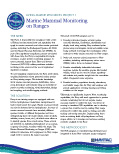 |
SOCAL Behavioral Response Study (Project #LMR-2) COMPLETED
Principal Investigator: John Calambokidis and Brandon Southall
This project increased our understanding of marine mammal reactions to sound and provided a robust scientific basis for estimating the effect of Navy mid-frequency active sonar (MFAS) on marine mammal behavior. Project was co-funded by ONR and SERDP.
|
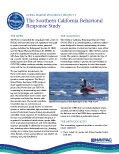 |
Simple Performance-characterized Automatic Detection of Marine Mammal Sounds (Project #LMR-3) COMPLETED
Principal Investigator: Dave Mellinger
This project developed user interfaces and training courses to facilitate usage of the Ishmael signal-processing toolkit by Navy staff and contractors, reducing the need for expensive external expert staffing.
|
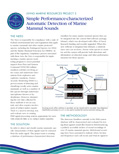 |
Demonstration of High-performance PAM Glider and Profiler Float (Project #LMR-4) COMPLETED
Principal Investigator: Haru Matsumoto
This project compared two alternative passive acoustic monitoring (PAM) technologies (gliders and drifting floating systems) to assess cost and performance relative to existing Navy PAM systems (moored and towed systems). The technologies demonstrated during this project are now available for use by the Navy’s marine species monitoring program.
|
 |
Developing Automated Whistle and Click Detectors and Classifiers for Odontocete Species (Project #LMR-5) COMPLETED
Principal Investigator: Julie Oswald
This project developed automated ondontocete detectors and classifiers using both whistles and clicks. The detectors and classifiers developed during this project increase the effectiveness of analyzing passive acoustic monitoring data. These tools are now available for use by the Navy’s marine species monitoring program and the scientific community.
|
 |
Database and Metrics for Testing Automated Signal Processing for Passive Acoustic Monitoring (Project #LMR-6) COMPLETED
Principal Investigator: John Hildebrand
This project is developing and maintaining a test data set for assessing new PAM signal processing systems to generate cost and performance metrics for new signal processing tools under consideration.
|
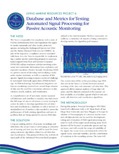 |
Technology Demonstration for Navy Passive Acoustic Monitoring (Project #LMR-7) COMPLETED
Principal Investigator: John Hildebrand
This project developed and demonstrated improvements to the High-frequency Acoustic Recording Package (HARP) moored passive acoustic monitoring (PAM) systems. The HARPs are being widely used by the Navy’s marine species monitoring program.
|
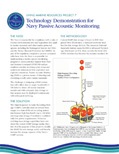 |
Improving the Navy’s Automated Methods for Passive Underwater Acoustic Monitoring of Marine Mammals (Project #LMR-8) COMPLETED
Principal Investigator: Tyler Helble
This project developed a suite of automated signal conditioning tools for normalizing data sets from different ambient acoustic regimes prior to submitting such data to standardized automated signal processing systems.
|
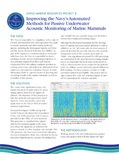 |
Electrophysiological Correlates of Subjective Loudness in Marine Mammals (Project #LMR-9) COMPLETED
Principal Investigator: Jim Finneran
This project investigated potential reasons why hearing data obtained by measuring auditory evoked potentials (AEPs) were not reliable for use in determining marine mammal weighting functions. Research found that low frequency stimuli produced both low and high frequency AEPs, and therefore the AEP measurements were not reliable at predicting perceived loudness in marine mammals at low frequencies.
|
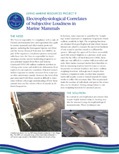 |
The Effects of Noise on Marine Mammals: Progress Since 1995 (Project #LMR-10) COMPLETED
Principal Investigator: Christine Erbe
This project is generating an updated review of the scientific information relevant to hearing in marine mammals and the effects of underwater sound. Project co-funded by ONR, JIP, and NMFS.
|
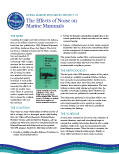 |
Audiograms of Hearing in Baleen Whales: A Model System for Mitigating Sound Impacts (Project #LMR-11) COMPLETED
Principal Investigator: Darlene Ketten
This project predicted a range of best hearing for the humpback whale based on a finite element model (FEM) of the middle ear.
|
 |
Integrated Real-time Autonomous Passive Acoustic Monitoring System (Project #LMR-12) COMPLETED
Principal Investigator: Phil Abbot
This project demonstrated the Integrated Real-time Autonomous Passive Acoustic Monitoring (IRAP) system on a powered autonomous underwater vehicle (REMUS-600).
|
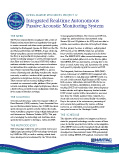 |
Standardization of AEP Audiometry Methods to Ensure Comparable Data Inclusion in a National Marine Mammal AEP Database (Project #LMR-13) COMPLETED
Principal Investigator: Dorian Houser
This project team published an ANSI standard to standardize data collection approaches for measuring Auditory Evoked Potential (AEP) hearing thresholds in toothed whales.
|
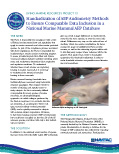 |
Behavioral Audiometry in Multiple Killer Whales (Project #LMR-14) COMPLETED
Principal Investigator: Brian Branstetter
The study provided the first demographic hearing data from killer whales by measuring behavioral audiograms for animals of multiple ages.
|
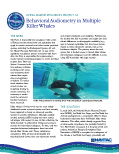 |
Jawphone Simulations to Maximize the Utility of Psychoacoustic and Auditory Evoked Potential Experiments (Project #LMR-15) COMPLETED
Principal Investigator: Ted Cranford
This project produced surface sensitivity maps for three odontocete species. Surface maps were also generated comparing in-air vs. in-water. Results suggest there may be significant consequences for sound reception mechanisms and optimal placement and use of jawphones.
|
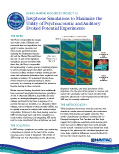 |
Passive Acoustic Density Estimation of Baleen Whales: Using Sonobuoys to Estimate Call-Rate Correction Factors (Project #LMR-16) COMPLETED
Principal Investigator: Shannon Rankin
This project served as a “proof of concept” for density estimation of baleen whales using sonobuoy data. The development work completed under this project can be used to improve analysis of sonobuoy data in general. The final report summarizes best practices, including suggested changes to data collection, acoustic software modifications; and identified analytical approaches appropriate for working with arrays of sonobuoys.
|
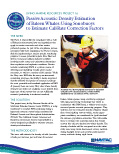 |
Blue and Fin Whale Density Estimation in the Southern California Offshore Range Using PAM Data (Project #LMR-17) COMPLETED
Principal Investigator: Ana Sirovic
This team will combine point transect methodology with available passive acoustic monitoring data to create population density estimates of calling blue and fin whales.
|
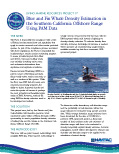 |
Acoustic Metadata Management for Navy Fleet Operations (Project #LMR-18) COMPLETED
Principal Investigator: Marie Roch
This project is creating an improved data collection platform technology to meet monitoring requirements.
|
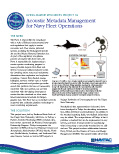 |
DECAF-TEA: Density Estimation for Cetaceans from Acoustic Fixed Sensors in Testing and Evaluation Areas (Project #LMR-19) COMPLETED
Principal Investigator: Len Thomas
The goal of this project is to demonstrate and validate a method for passive acoustic density estimation for cetaceans by combining data from instrumented and non-instrumented ranges.
|
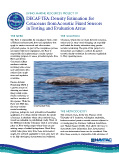 |
Behavioral Dose-Response Relationship and TTS in Harbor Porpoises (Project #LMR-20) COMPLETED
Principal Investigator: Ron Kastelein
This project is working to establish a behavioral dose–response relationship for sonar signals around 3 kHz in harbor porpoises.
|
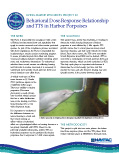 |
Extended Duration Acoustic Tagging of Right Whales (Project #LMR-21) COMPLETED
Principal Investigator: Susan Parks
This project is testing a new longer-lasting attachment method for digital tags.
|
 |
Hearing and Estimated Acoustic Impacts in Three Species of Auk: Implications for the Marbled Murrelet (Project #LMR-22) COMPLETED
Principal Investigator: Aran Mooney
This project is measuring the hearing of up to three Auk species to provide key hearing data needed to define acoustic criteria for the marbled murrelet.
|
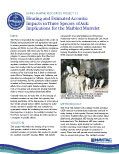 |
Cuvier’s Beaked Whale and Fin Whale Behavior During Military Sonar Operations: Using Medium-term Tag Technology to Develop Empirical Risk Functions (Project #LMR-23) COMPLETED
Principal Investigators: Greg Schorr, Erin Falcone
The effort will generate significantly larger samples of high-resolution behavioral data, particularly for beaked whales, to support development of risk functions.
|
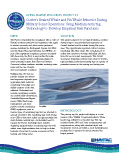 |
Frequency-dependent Growth and Recovery of TTS in Bottlenose Dolphins (Project #LMR-24) COMPLETED
Principal Investigator: James Finneran
The data that results from this effort will help to define weighting functions and Temporary Threshold Shift/Permanent Threshold Shift values for mid-frequency cetaceans.
|
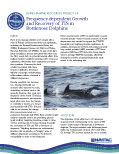 |
A Blainville’s Beaked Whale Behavioral Risk Function for Hawaiian Populations (Project #LMR-25) COMPLETED
Principal Investigators: David Moretti, Len Thomas
This effort will result in the publication of the first behavioral risk function for the Blainville’s beaked whale at the Pacific Missile Range Facility.
|
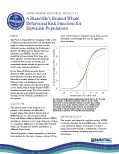 |
The Effects of Underwater Explosions on Fish (Project #LMR-26) COMPLETED
Principal Investigator: Peter Dahl
The results from this project will help to predict potential effects to fish that may occur during Navy explosives training activities.
|
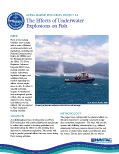 |
High Fidelity Acoustic and Fine-scale Movement Tags (Project #LMR-27) COMPLETED
Principal Investigator: Alex Shorter
This project will build new generation digital tags (DTAG-3s) to be field-tested during upcoming behavioral response studies.
|
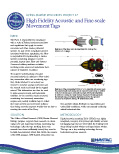 |
Proposed ASA Standards on Towed Passive Acoustic Monitoring and Mitigation Systems (Project #LMR-28) COMPLETED
Principal Investigator: Aaron Thode
This project would help to support development of an American National Standard on towed cabled PAM systems and operations for monitoring and mitigation.
|
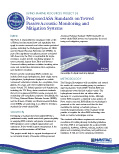 |
3S3: Behavioral Responses of Cetaceans to Naval Sonar (Project #LMR-29) COMPLETED
Principal Investigators: Frans-Peter Lam, Petter Kvadsheim, Patrick Miller
The 3S (Sea mammals, Sonar, Safety) project, an international cooperative project now in its third phase, is evaluating whether exposure to continuously active sonar leads to different types or severity of behavioral responses than exposure to pulsed active (also called intermittent) sonar signals. In addition, the project is evaluating how the distance to the source affects behavioral responses.
|
 |
Measuring the Effect of Range on the Behavioral Response of Marine Mammals Through the Use of Navy Sonar (Project #LMR-30) COMPLETED
Principal Investigator: Stephanie Watwood
To assess the effect of sonar source sources and distance (range), researchers are conducting controlled exposure experiments (CEE) with sonar from two different platforms. Each will be deployed at multiple, pre-defined distances from tagged animals to collect data on responses.
|
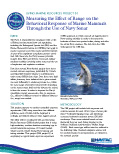 |
DenMod: Working Group for the Advancement of Marine Species Density Surface Modeling (Project #LMR-31) COMPLETED
Principal Investigator: Len Thomas
This effort is coordinating a group of density surface modeling (DSM) specialists to assess the varied approaches to and coordinate advances on using DSM models. These experts are focused on developing and implementing innovative approaches to improve spatial modeling methods used to characterize seasonal abundance and distribution of marine species, particularly in U.S. Navy training and testing areas.
|
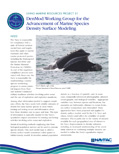 |
TTS in Harbor Seals Due to Fatiguing Sound of Several Frequencies (Project #LMR-33) COMPLETED
Principal Investigator: Ron Kastelein
This project focuses on measuring TTS and hearing recovery in harbor seals for deriving auditory weighting functions for seals.
|
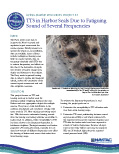 |
Standardizing Methods and Nomenclature for Automated Detection of Navy Sonar (Project #LMR-34) COMPLETED
Principal Investigators: Elizabeth Henderson and Susan Jarvis
This project is seeking to develop a set of standardized detectors and classifiers, along with a set of standardized nomenclature, for Navy sonar signals.
|
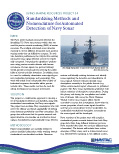 |
Multi-spaced Measurement of Underwater Sound Fields from Explosive Sources (Project #LMR-35) COMPLETED
Principal Investigator: Peter Dahl
This project will conduct calibrated underwater acoustic field measurements associated with explosive detonations, which will be used to update the Navy’s Acoustic Effects Model.
|
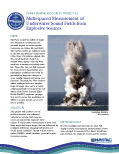 |
Analytical Methods to Support the Development of Noise Exposure Criteria for Behavioral Response (Project #LMR-36) COMPLETED
Principal Investigators: Len Thomas and Catriona Harris
This project is focused on developing a computationally efficient model selection method that could expand the utility of data collected from behavioral response studies and improve the approach to grouping species for risk threshold criteria.
|
 |
Use of 'Chirp' Stimuli for Non-invasive, Low-frequency Measurement of Marine Mammal Auditory Evoked Potentials (Project #LMR-39) COMPLETED
Principal Investigator: James Finneran
This project seeks to contribute to developing tools needed to advance AEP measurements below 1 kHz by examining the potential for frequency-modulated, upward sweeping “chirp” stimuli to enhance marine mammal auditory brainstem response (ABR) amplitudes across a broad range of frequencies, including frequencies below 1 kHz.
|
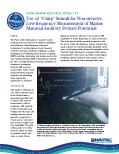 |
Temporary Threshold Shifts in Underwater Hearing Sensitivity in Freshwater and Marine Turtles (Project #LMR-40) COMPLETED
Principal Investigators: Aran Mooney, Wendy Dow Piniak
This project is examining TTS in aquatic turtles and will potentially provide the initial sound exposure levels that induce these temporary threshold shifts. Resulting data could improve estimates of noise impacts to both freshwater and sea turtles and guide the development of a TTS study with sea turtles.
|
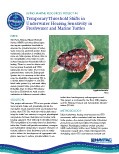 |
Demonstration and Validation of Passive Acoustic Density Estimation for Right Whales (Project #LMR-44) COMPLETED
Principal Investigators: Susan Parks, Len Thomas
This project is focused on demonstrating passive acoustic density estimation methods and validating these methods using concurrent visual density estimation techniques.
|
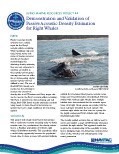 |
Collection of in situ Acoustic Data for Validation of U.S. Navy Propagation Models of Ship Shock Trial Sound Sources (Project #LMR-48) COMPLETED
Principal Investigators: Kerri Seger, Shyam Madhusudhana and Holger Klinck
This project is collecting relevant in situ data on the acoustic shock wave propagation during the full ship shock trial of the new Navy aircraft carrier, USS Gerald R. Ford (CVN-78). The data will help the Navy to validate the underlying acoustic propagation model used within the Navy Acoustic Effects Model (NAEMO).
|
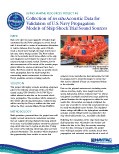 |
Studying Marine Mammal Behavioral Response to Surveillance Towed Array Sensor System Low Frequency Active (SURTASS LFA) Sonar (Projects #LMR-52,53,54) COMPLETED
Principal Investigators: (#52) Adam Frankel, (#53) John Calambokidis, (#54) Stephanie Watwood
The overall goal of this two-phase effort is to update previous studies done with LFA sources during the 1990s, based on lessons learned and best practices from controlled and observational behavioral response studies using other sonar sources conducted over the last 10 years. As part of the Phase I feasibility study, these projects are investigating the best approach to designing a scientific study to assess behavioral response to LFA sonar.
|
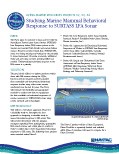 |
Dolphin Conditioned Hearing Attenuation (Project #LMR-55) COMPLETED
Principal Investigator: James Finneran
This work, co-funded by the LMR program and the Naval Innovative Science and Engineering (NISE) program, is assessing conditioned hearing attenuation in bottlenose dolphins. The project will measure how quickly dolphins can learn to suppress (i.e., attenuate) their hearing in anticipation of an impending intense sound, determine how long they can maintain the attenuation and assess the role of outer hair cells in the conditioned hearing change.
|
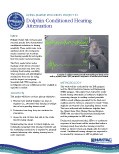 |
Bryde’s Whale Cue Rates and Kinematics (Project #LMR-58) COMPLETED
Principal Investigator: Tyler Helble
This effort will develop information needed to determine the feasibility of using animal cue rate (calling rate) and the cue stability for acoustic density estimation.
|
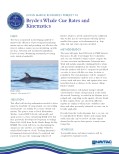 |
Auditory Masking in Odobenid and Otariid Carnivores (Project #LMR-61) COMPLETED
Principal Investigators: Colleen Reichmuth, Jillian Sills
This project will provide auditory data for odobenid and otariid carnivores (Pacific walruses and California sea lions, respectively) needed to compare the acoustic sensitivity between these marine mammal taxa and support environmental compliance efforts.
|
 |
Autonomous Real-Time Passive Acoustic Monitoring of Baleen Whales for Mitigating Interactions with Naval Activities (Partnership Project) COMPLETED
Principal Investigators: Cara Hotchkin, Mark Baumgartner, Sofie Van Parijs
This project will demonstrate, on three autonomous platforms, a combined passive acoustic detection and classification hardware/software system that is capable of detecting the calls of four species of endangered baleen whales in near real time. The project is a partnership between the LMR program and Environmental Security Technology Certification Program.
|
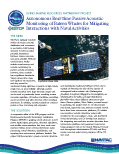 |
Developing Tools for Acoustic-only Behavioral Response Studies at Navy Instrumented Ranges (Partnership Project) COMPLETED
Principal Investigators: Tyler Helble, Elizabeth Henderson
This project will develop tools to aid in extracting whale swim track kinematic data more efficiently from the Navy range hydrophone data. Main goals include developing an acoustic modeling software interface, automated track kinematics software, and automated classification of track information.
|
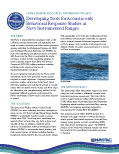 |